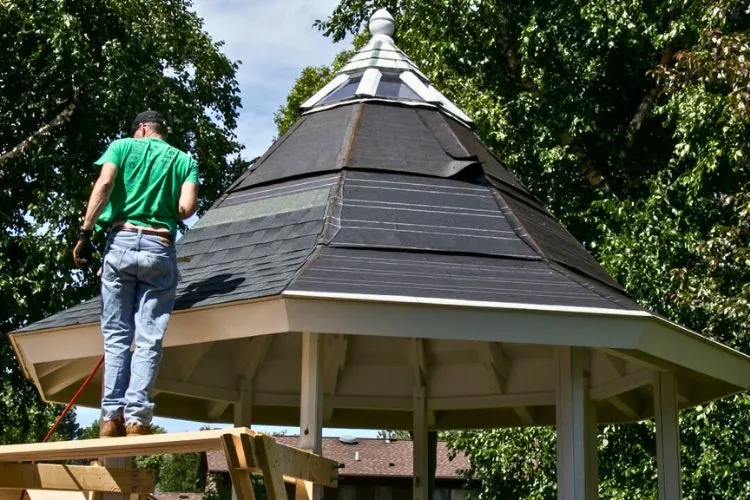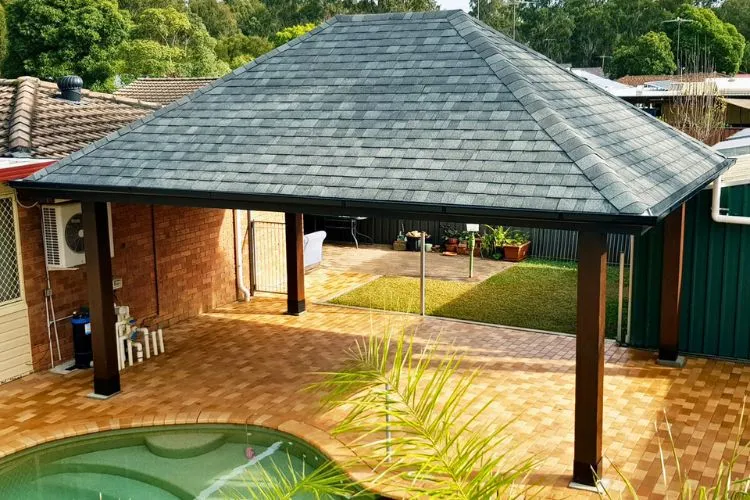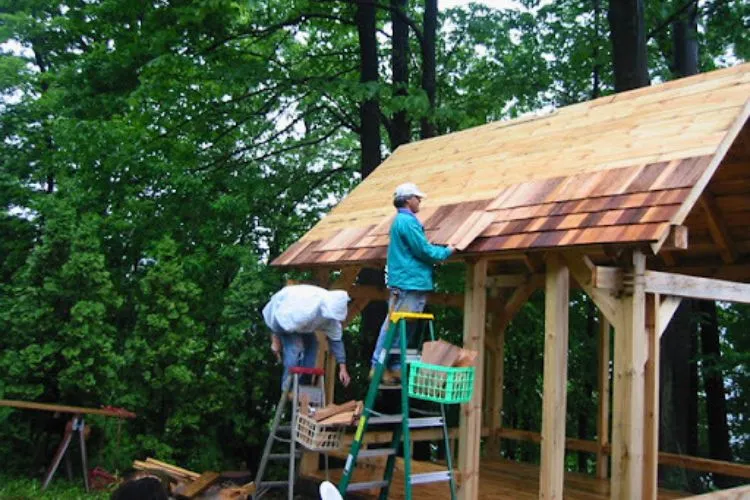Learning how to shingle a gazebo roof is a significant step in ensuring its longevity and functionality.
This process involves covering the roof with shingles, which protects it from the weather and adds to the overall aesthetic appeal of the structure.
The benefits of shingling a gazebo roof are manifold, ranging from enhanced weather protection to improved visual appeal.
Shingling requires careful planning, the right materials, and a step-by-step approach to ensure success.

Contents
Preparing for the Project
Assessing the Roof Structure
Before beginning any work, it is crucial to check the gazebo’s roof for any damage.
Repairs should be made to ensure the structure is sound and capable of supporting the weight of the shingles. This step is vital for the longevity of the shingled roof.
Choosing the Right Materials
Selecting the appropriate type of shingles is next. Asphalt and cedar shingles are among the most common choices, each with unique benefits.
While making this choice, consider factors like durability, cost, and the overall look you want to achieve.
Additionally, gather other necessary materials such as underlayment (for water protection), nails, and roofing cement.

Tools and Safety Equipment
A list of required tools includes a hammer, utility knife, and possibly a nail gun. Safety should be a top priority.
Wear gloves, safety glasses, and sturdy shoes to protect against accidents. Setting up the workspace safely can prevent injuries.
How To Shingle A Gazebo Roof? A Step-By-Step Guide
Installing the Underlayment
The underlayment is the barrier that prevents water from reaching the wood structure beneath the shingles.
Rolling it out and securing it with nails is the first step in the shingling process. Ensure that it covers the entire surface area for maximum protection.
Planning Your Shingle Layout
Measuring the roof and planning the layout of the shingles can help avoid unnecessary waste and ensure that the shingles are evenly distributed across the roof.
Consider the gazebo’s unique features, and plan how to cut and fit shingles around them.
Applying the Starter Shingles
Starter shingles are laid along the edge of the roof to provide a solid base for the rest of the shingles.
They are essential for preventing water ingress at the roof’s edges. Follow the manufacturer’s instructions for the best results.
Shingling the Roof
Starting from the bottom and working your way up, lay the shingles, making sure to overlap them properly.
This overlap is critical for water resistance. Cut and fit the shingles as needed, maintaining a uniform look while ensuring each piece is securely fastened.
Finishing Touches
The last step involves installing ridge cap shingles along the roof’s peak. These special shingles help seal off the ridge, keeping water out.
Applying roofing cement under the edges of shingles can further enhance water resistance.
Choosing Shingle Color and Style
Choosing the right shingle color and style for your gazebo roof is pivotal, not only for aesthetics but also for functional considerations.
Personal aesthetic preferences play a significant role; the shingles should reflect your style and complement the overall look of your property.

Whether you prefer a modern, sleek appearance or a more traditional, rustic vibe, there’s a plethora of options to suit various tastes.
Additionally, it’s important that the shingle color harmonizes with existing structures and landscaping to create a cohesive and attractive outdoor space.
Choosing a color that either contrasts beautifully or blends seamlessly with your home and garden can enhance the overall appeal of your property.
Heat reflection and absorption should not be overlooked. Light-colored shingles tend to reflect sunlight, helping to keep the gazebo cooler during hot months, while dark-colored shingles can absorb heat, potentially making the gazebo warmer.
This can affect not only your comfort but also energy costs if the gazebo is attached to your home or constitutes a significant part of your outdoor living space.
Common Mistakes to Avoid
One common mistake is placing nails incorrectly. Ensure that each shingle is fastened firmly in place without damaging its integrity.
Additionally, insufficient overlap between shingles can lead to leaks, so always follow the recommended overlap measurements.
Maintenance and Care for Your Shingled Gazebo Roof
Regular maintenance can extend the life of your shingled roof. Inspect it seasonally for signs of damage, such as missing shingles or leaks, and clean it to prevent the build-up of debris. Addressing issues promptly can prevent major repairs later.
Pro Tips
Working in mild weather conditions, such as on an overcast day, can make the job more manageable and help the shingles set correctly.
Starting from the bottom allows you to securely overlap shingles, an essential factor in preventing water damage.
Frequently Asked Questions (FAQs)
Can I shingle a gazebo roof myself, or should I hire a professional?
It depends on your skills and confidence. This guide provides a good starting point, but hiring a professional is advisable if you’re unsure.
How long do shingled gazebo roofs last?
With proper maintenance, a shingled gazebo roof can last 20 years or more, depending on the materials used and the climate.
What’s the best time of year to shingle a gazebo roof?
Late spring or early fall, when the weather is mild and dry, is ideal. This prevents the shingles from being too brittle or too soft to work with.
How do I choose the right type of shingles for my gazebo roof?
Consider factors such as the overall style of your gazebo, the climate in your area, and your budget. Research and consult with professionals if in doubt.
Can I install shingles over an existing gazebo roof?
It’s not recommended, as the old roofing materials may hinder the new roof’s performance and longevity. It’s best to remove the old materials first.
Conclusion:
Shingling a gazebo roof, while challenging, is a rewarding project that adds beauty and functionality to your outdoor space.
By preparing properly, choosing the right materials, and following a step-by-step approach, you can achieve a durable and attractive roof.
The key to success lies in careful planning and attention to detail.
By adhering to these guidelines, you can successfully shingle your gazebo roof, ensuring it stands as a proud focal point in your garden for years to come.

Sergio Gomes, a passionate advocate for outdoor living and the male voice behind Shades Authority. With years of experience, Sergio is your trusted source for expert insights on gazebos, pavilions, cabanas, pergolas, and all things outdoor shade solutions. Join him on a journey to transform your outdoor spaces into stunning, functional retreats
